Back in the mid-18th century, when studying the structure of stones formed in the gallbladder, a previously unknown substance was isolated. After 20 years, he was called cholesterol, a word that is translated from Greek as “gallstone”. This compound has been studied for a long time, its role in the human body, variety, and only in the second half of the 20th century it became finally known how dangerous cholesterol can be. How to lower cholesterol at home and eat right, is it worth changing your lifestyle - questions everyone should know the answers to.
Material Content:
- 1 What is cholesterol?
- 2 Kinds. Bad and good cholesterol: what's the difference?
- 3 Accurate diagnosis: we take tests for cholesterol
- 4 Causes and consequences of high cholesterol
- 5 Causes and Consequences of Low Cholesterol
- 6 Cholesterol-lowering and cleansing vessels
- 7 Lowering cholesterol at home
- 8 What is forbidden to use
- 9 How to increase the level of "good" cholesterol and reduce the level of "bad" with exercise?
What is cholesterol?

From a chemical point of view, cholesterol is a monoatomic secondary alcohol that is highly soluble in fats and poorly in water. This is an organic compound, a type of lipid that is synthesized mainly in the liver and performs many important functions for the body. It binds well with proteins, acids, many salts, carbohydrates.
From a biological point of view, cholesterol is a necessary component of many vital biochemical reactions that occur in almost all living organisms.
Its role in the human body boils down to:
- fulfillment of the “construction” function, that is, cholesterol is a part of all cells and ensures the stability of cell membranes;
- participation in the exchange of bile acids necessary for proper digestion (absorption of fats);
- the role of the precursor of steroid and sex hormones, the synthesis of which is impossible without cholesterol;
- participation in the synthesis of vitamin D.
In an adult, the body contains about 2 mg of cholesterol per 1 kg of weight.
Depending on the involvement in biochemical processes, all cholesterol is divided into:
- Rapidly exchanged, found in the liver, intestinal wall and blood. It is this cholesterol that is used in most metabolic processes.
- Slowly exchanging, including cholesterol in other organs, except the nervous system.
- Very slowly exchanged, accumulating in the nervous system.
A relatively constant amount of cholesterol is maintained due to its regular intake with food and synthesis in the body. Moreover, about 500 mg per day comes from outside, and 800 mg per day is synthesized.
The formation of cholesterol occurs in:
- liver - 80%;
- the wall of the small intestine - 10%;
- skin - 5%;
- other organs - 5%.
Therefore, the main source of internal cholesterol is the liver. This largest abdominal parenchymal organ synthesizes cholesterol not only for the whole organism, but also for its cells.
The synthesis of cholesterol in the human body is a collection of 25 consecutive chemical reactions that occur under the action of special enzymes. However, the key substance on which the rate of formation of cholesterol depends is hydroxymethylglutaryl-CoA reductase or simply HMG-CoA reductase. The most common group of drugs that help reduce cholesterol - statins - act by suppressing the activity of this particular enzyme.
Kinds. Bad and good cholesterol: what's the difference?
The exchange of cholesterol is carried out in various organs, so it must be transported inside the liver itself through the bloodstream, to the places of its destruction or storage, and vice versa.
For this, the body has transport lipoproteins (LPs), which are slightly different in their structure:
- VLDL - very low density lipoproteins;
- LPPP - transition density lipoproteins;
- LDL - low density lipoproteins;
- HDL - high density lipoproteins.
High triglyceride lipoproteins
VLDLP is the main transport form of lipids that are synthesized in the body.
They contain:
- about 20% of cholesterol;
- up to 20% phospholipids;
- up to 70% triglycerides.
After entering the bloodstream, VLDLPs break down and release triglycerides, which enter the adipose, muscle tissue and heart for use as energy.
High cholesterol lipoproteins
These forms of lipoproteins are called "bad" because their excessive formation contributes to the deposition of cholesterol in the vessels, the formation of atherosclerotic plaques and the development of severe pathology.
- Lobb
This form of lipoproteins is formed as a result of the splitting of VLDL and contains a large number of cholesterol:
- total cholesterol about 40-45%;
- triglycerides up to 34%;
- phospholipids about 15%.
Most of them are absorbed by the liver, and the remaining amount is converted into low density lipoproteins.
2. LDL
The largest amount of cholesterol is contained in this form of PL, which are synthesized by the liver and are formed from transition density lipoproteins.
Structure:
- total cholesterol 50%;
- triglycerides up to 10%;
- phospholipids about 25%.
75% of LDL cholesterol goes to the needs of the liver, adrenal glands and other organs, tissues.The second metabolic pathway is involved in atherosclerosis - peroxidation, leading to the formation of components of atherosclerotic plaques.
High phospholipid lipoproteins

HDLs are called “good” because their main function is to transfer cholesterol from peripheral tissues and the bloodstream to the liver for further metabolism.
The composition of these drugs has distinctive features:
- more than half of their structure is protein (up to 65%);
- total cholesterol about 25%;
- phospholipids up to 40%;
- a small amount of triglycerides.
They are formed as a result of VLDL metabolism and are synthesized by the liver.
Atherogenic and non-atherogenic lipoproteins
Based on the composition and metabolism, all lipoproteins are divided into two types:
- contributing to the formation of atherosclerotic plaques - LDL;
- preventing the deposition of cholesterol on the walls of blood vessels - HDL.
High density lipoproteins are so small that they are able to penetrate the vascular wall, take excess cholesterol, freely exit and transport cholesterol to the liver. At the same time, they help restore tissue at the cellular level: they update the internal structures of the cell and its wall with the help of phospholipids.
Low density lipoproteins can pass into the vessel wall, remain there and modify, contributing to the development of atherosclerosis.
Accurate diagnosis: we take tests for cholesterol
The level of cholesterol is determined during a biochemical blood test.
To obtain more complete information, based on which reliable conclusions can be made, a lipid profile should be performed. This is an analysis of venous blood, which reflects the content of total cholesterol (OX), triglycerides, cholesterol in LDL, cholesterol in HDL, which is used to calculate the atherogenic index (coefficient).
Read also:atherogenic coefficient increased
Normal indicators of the lipid spectrum of the blood are presented in the table:
| Indicator | Normal value |
|---|---|
| Total cholesterol | 3-5.2 mmol / l |
| Triglycerides | 0.15-1.82 mmol / L |
| Cholesterol | less than 3.9 mmol / l |
| HDL cholesterol | more than 1.42 mmol / l in women more than 1.68 mmol / l in men |
| Atherogenic index | less than 3 |
Determination of IA is necessary to identify the ratio of atherogenicity of LP to antiatherogenic.
The formula for calculating: IA = (OX - HDL cholesterol) / HDL cholesterol
The higher the index, the greater the likelihood of developing a pathology. On the contrary, its value less than 3 means that the body contains more “good” cholesterol, which fights against atherosclerosis.
The correct description of the lipid profile can only be obtained from a qualified specialist, since there are certain nuances that depend on:
- age and gender of the patient;
- burdened family history, that is, cases of pathological increase in cholesterol in close relatives;
- risk factors such as smoking, overweight and others;
- the presence of pathology not associated with an increase in the level of cholesterol, for example, bronchial asthma, diabetes mellitus, etc .;
- the presence of concomitant diseases associated with elevated cholesterol, for example, hypertension, coronary heart disease, atherosclerosis obliterans of the legs, etc .;
- acute vascular pathology that occurred earlier (heart attack, stroke).
If an elevated level of total cholesterol is determined in a blood test, but the amount of cholesterol in LDL is not increased, this indicates a normal physiology associated with an increase in the amount of “good” cholesterol. Often this condition can be observed in young people who are actively involved in sports. You should be aware that such a result should be accompanied by a normal value of the atherogenic index. Otherwise, an error has occurred.
Causes and consequences of high cholesterol
The factors that increase the amount of cholesterol in the blood can be divided into primary and secondary.However, its isolated increase is rarely observed, more often there is a simultaneous increase in the amount of cholesterol and triglycerides.
The primary causes include genetic diseases that are not amenable to correction.
Secondary causes of hypercholesterolemia and hypertriglyceridemia:
- weight gain - obesity;
- decreased thyroid function, i.e. hypothyroidism;
- impaired glucose metabolism - diabetes;
- severe infectious processes (sepsis);
- kidney pathology leading to chronic renal failure;
- inflammatory processes of the liver - acute hepatitis;
- diseases that result in a violation of the outflow of bile due to blockage of the bile ducts;
- prolonged and severe stressful situations;
- pregnancy;
- excessive alcohol consumption.

Prolonged or regular intake of certain medications can also lead to an increase in cholesterol:
- hormonal drugs - progesterone, estrogens, glucocorticoids;
- diuretics - thiazides (hydrochlorothiazide);
- immunosuppressant cyclosporin;
- β-blockers (Atenolol, Bisoprolol, Metoprolol and others).
Factors contributing to a decrease in the amount of “good” lipoproteins are singled out separately, which increases the risk of developing atherosclerosis.
These include:
- weight gain;
- smoking;
- long-term use of anabolic steroids;
- malnutrition;
- treatment with β-blockers.
When cholesterol is retained in the vascular wall, atherosclerotic plaque forms, that is, the development of atherosclerosis. This is a chronic disease of arteries that occurs due to impaired fat metabolism.
If the disease is left to chance, then it will inevitably lead to acute or chronic damage:
- heart - heart failure, acquired defects, myocardial infarction;
- brain - dementia, stroke;
- kidneys - renal failure, heart attack, nephrosclerosis;
- legs - gangrene.
Any of the manifestations of atherosclerosis is a serious consequence of increasing the level of "bad" cholesterol. Therefore, you need to know what high cholesterol is: how to lower its level in the blood in all available ways.
Causes and Consequences of Low Cholesterol
A decrease in the amount of cholesterol in the blood is quite rare and can occur more often due to severe pathology:
- tuberculosis;
- AIDS;
- lymphoma
- malabsorption - malabsorption in the small intestine;
- a prolonged increase in thyroid function - thyrotoxicosis;
- prolonged severe liver disease, due to which there is a violation of cholesterol synthesis.
Often a low level of cholesterol indicates a depletion of the body, which can occur with a long unbalanced diet.
With a significant decrease in the number of cholesterol, there will be signs of insufficiency of those processes in which it is involved:
- problems with the synthesis of hormones of the adrenal glands, sex hormones;
- lack of vitamin D due to problems in its production;
- digestion and liver problems.
Any substance synthesized by the human body plays its own unique role in metabolic processes. Therefore, it is important that a certain balance is maintained between its intake, synthesis and consumption.
Cholesterol-lowering and cleansing vessels
Before starting treatment, that is, taking therapeutic measures to lower cholesterol, experts strongly recommend modifying the diet. This means that it is necessary to eat more foods that lower cholesterol and to exclude increasing its level.
It is interesting: cholesterol lowering foods
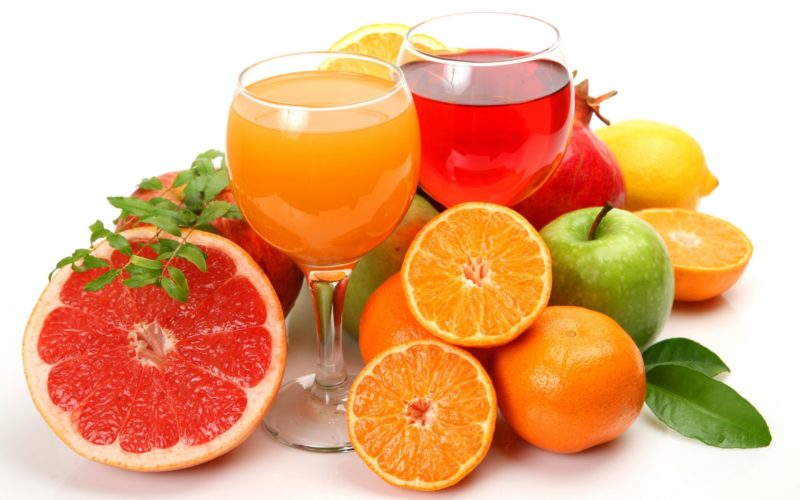
Since the main target of this substance is the arteries, it is therefore important not only to reduce the amount of cholesterol in the blood, but also to ensure that it does not linger in the vessels.
What foods lower cholesterol?
Regular use of the following diet components can lower cholesterol levels:
- Salmon, mackerel.These marine fish varieties reduce cholesterol by normalizing lipid balance, as they are rich in omega-3 polyunsaturated fatty acids.
- Fish oil is often called "natural statin" because of its ability to regulate the lipid ratio in the direction of "good". However, the fat of marine fish, which is obtained from their carcasses, has a great effect.
- Garlic. This spice is often referred to as a product that improves blood flow by cleansing blood vessels. This happens due to the high content of phytosterols in it - these substances slow down the production of LDL cholesterol. However, there are contraindications to its long-term use associated with the sensitivity of the esophagus, stomach and duodenum.
- Oatmeal and whole grains. Eating these foods regularly will help cleanse your intestines. Since cholesterol (both supplied from the outside and synthesized in the body) is absorbed in the small intestine, and whole grains help to remove excess substances from their digestive tract, their use will lower blood cholesterol.
- White cabbage, any greens. These products follow the example of whole grains due to their high fiber content.
- Olive oil, as well as fish oil, contains omega-3 polyunsaturated fatty acids, which contribute to lowering both LDL and HDL. Therefore, do not abuse this product.
- Avocado is a storehouse of vitamins that make up the group of antioxidants, as well as polyunsaturated acids. Their combined effect will lead to a decrease in lipid levels.
- Blueberries, raspberries, aronia, pomegranate. The berries contain polyphenols that can stimulate HDL synthesis up to 5% per month with regular consumption. And also contain a relatively large amount of fiber in the form of pectin.
- Freshly squeezed vegetable and fruit juices, such as celery, carrots, beets, apples, are an excellent addition to a diet aimed at lowering cholesterol.
- Green tea. Weak, unpackaged and sugar-free, this drink also has not only antioxidant properties, but also lipid-lowering, that is, it can lower blood cholesterol.
Also in this list you can include any product containing water-soluble fiber (pectin, gluten), as it can reduce cholesterol.
You must always remember that excessive consumption of any one product can lead to a disastrous result. When modifying nutrition, an important principle is to create a balanced, varied menu.
Lowering cholesterol at home
Drugs that lower blood cholesterol are used after an unsuccessful attempt to adjust its level by diet and only on the recommendation of a doctor. Self-administration and medication is unacceptable!
Sequestrants of bile acids
Their mechanism of action is based on the ability to bile bile acids in the intestine, which is why the latter are not absorbed, but are excreted from the body. The drugs of this group are good because they are not absorbed into the bloodstream, but “work” only in the intestine, therefore they have a good efficiency / safety ratio.
Sequestrant representatives:
- Cholestyramine;
- Colestipol.
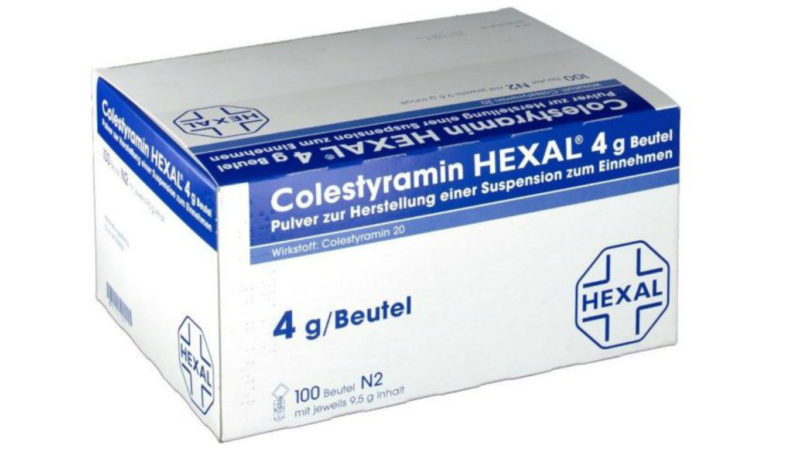
An important feature of taking these medicines is that they lower the amount of cholesterol and do not affect (and sometimes even increase) the level of triglycerides.
Medications that inhibit the absorption of cholesterol in the intestines
This group of medicines includes herbal preparations containing extract from the roots of dioscorea (Polisponin), creeping herbs (Tribusponin), dietary fiber seeds of hyacinth beans (Guarem).
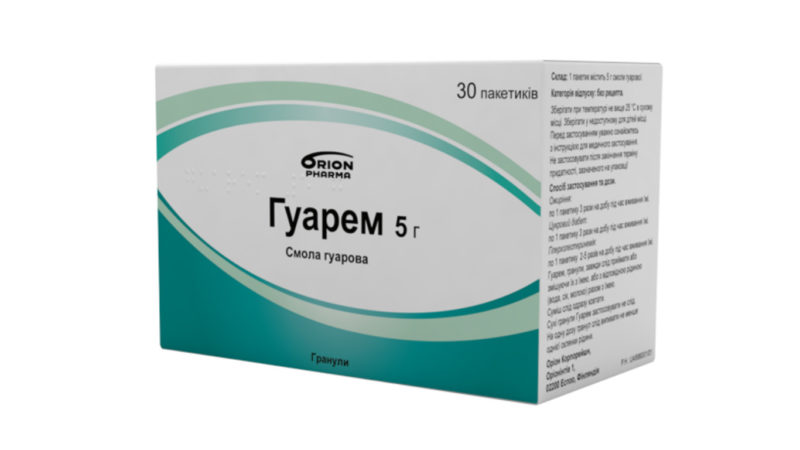
The mechanism of their action is based on two effects by which it occurs:
- an obstacle to its absorption;
- mechanical removal of cholesterol from the intestine.
A nicotinic acid
Niacin belongs to the B vitamins and has been shown to reduce the amount of cholesterol and triglycerides in several ways.He showed himself especially well in combination with sequestrants of bile acids.
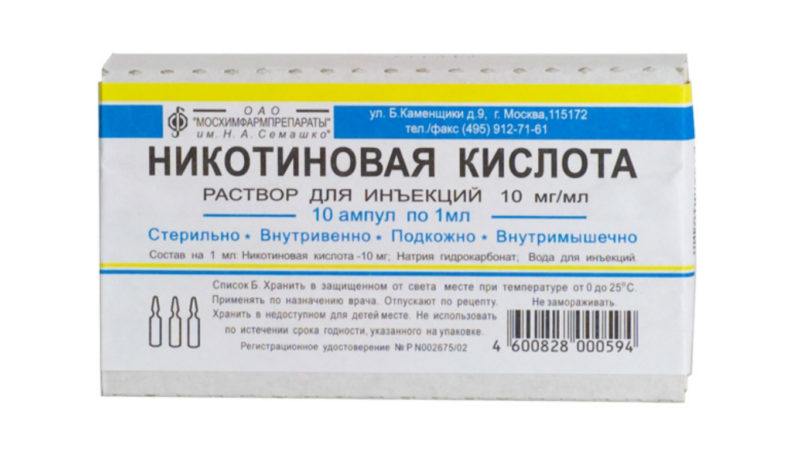
However, nicotinic acid can cause side effects, such as:
- irritation of the upper digestive tract - esophagus, stomach, duodenum;
- redness, itching of the skin;
- an increase in the activity of liver enzymes is observed with the appointment of large doses of the drug;
- an increase in blood glucose is possible, therefore, niacin is not recommended for patients with diabetes;
- increased uric acid levels, which is a contraindication for use in patients with gout.
Fibrates
Derivatives of fibric acid are directed to suppress the synthesis of triglycerides, that is, drugs of this group are recommended to be taken when there is an increase in cholesterol and triglycerides.
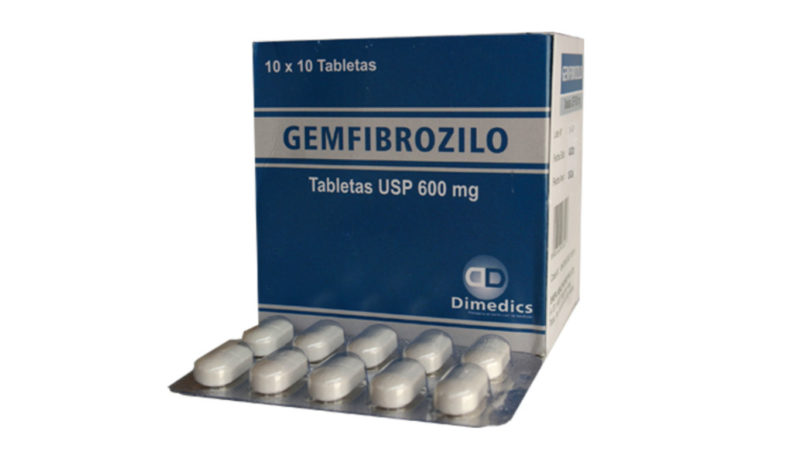
The effects of most fibrates come down to:
- decrease triglycerides;
- lower cholesterol;
- LDL reduction
- increased HDL.
A typical representative is the drug Gemfibrozil, the use of which is contraindicated in patients with cholelithiasis and liver pathology.
Statins
The most famous and common group of drugs that block the synthesis of cholesterol and the formation of LDL.

The best effect is possessed by drugs isolated from natural components:
- Lovastatin;
- Simvastatin.
Both drugs are isolated from mushrooms and are a "prodrug", that is, getting into the body, they turn into an active form.
There are also synthetic drugs, for example, Atorvastatin, the effectiveness of which is slightly lower, but the likelihood of side effects is also minimal.
What's better?
Cholesterol lowering drugs should be used differentially.
If you need to reduce the number of cholesterol and cholesterol, statins are not equal, but they slightly increase the amount of HDL, that is, "good" cholesterol. Nicotinic acid copes well with the latter.
To reduce triglycerides, it is better to choose nicotinic acid, fibrates, or a combination thereof.
Treatment with folk remedies
An excellent addition to the treatment of atherosclerosis, which develops due to an increase in "bad" cholesterol, are recipes of alternative medicine.
Lemon
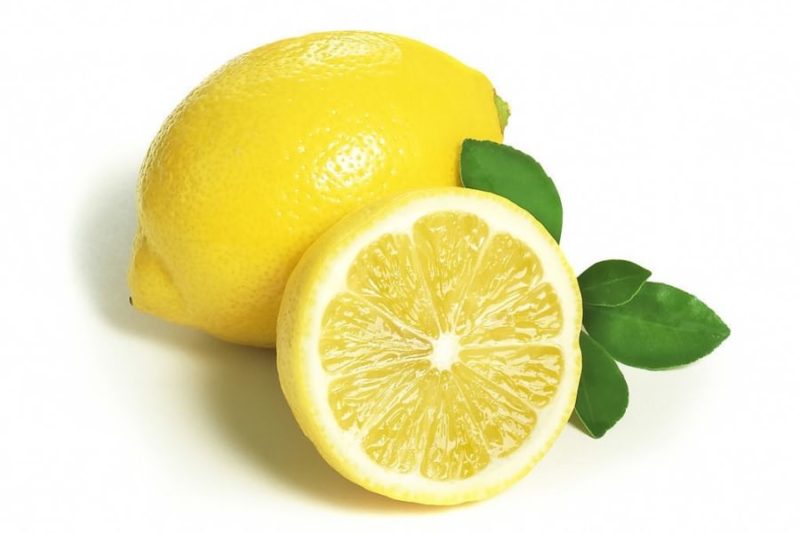
To normalize the level of cholesterol, you can use juice, pulp of fruit or eat whole.
Juice helps only if it is freshly squeezed. To prepare it, you need one lemon and boiled cold water, the amount of which should be 1: 1 in ratio to juice. Drink juice should be half an hour before each meal. If the drink cannot be drunk due to taste or irritation, then you can use ½ lemon or add half a teaspoon of honey.
Chopped lemon pulp is used in a mixture with finely chopped garlic and horseradish root. The mixture is poured with hot water in a ratio of 1: 1 and insisted in a dark, cold place for one day. Use the infusion of 1 tablespoon half an hour before meals.
To prepare the next mixture, you will need a carefully washed lemon and a tablespoon of honey. The fruit along with the peel must be chopped in a meat grinder or blender to preserve the juice. Add honey to the resulting mass and mix, after which take the mixture also before meals, 1 teaspoon. Keep the mixture in the refrigerator and do not use for more than two days.
Garlic

Spice, without which no hostess can do, is a source of natural substances that lower cholesterol. It helps even if you regularly consume garlic in a vegetable salad in olive oil.
Also, a good effect can be achieved by swallowing 2-3 cloves of garlic on an empty stomach. However, not every stomach can withstand it, so this treatment should be carried out with caution.
The alcohol tincture of garlic can be prepared as follows: pour garlic, chopped with a blender, weighing about 300 grams, pour 200 ml of alcohol. Infuse the mixture for about 10 days in a dark, cold place. Take 20 drops in a small amount of milk before using the entire tincture.
Healing herbs

Many herbs and their fees will help cope with high cholesterol. Among them:
- Golden Mustache or Fragrant Collision. An infusion is prepared from a finely chopped leaf of a plant, filled with 250 ml of hot water and wrapped in a dense dark cloth. Infuse the mixture for a day, and take 1 tablespoon before meals.
- Licorice. To obtain a therapeutic effect, dried and ground root of the plant is used. 2 tablespoons of the product pour 500 ml of hot water and simmer the mixture on fire for about 10-15 minutes. After this, the broth should be allowed to cool and take ½ cup 4 times a day. The medicine is prepared only for one day and is not stored! Treatment is carried out for 2-3 weeks, then a month break.
- Dioscorea Caucasian. The rhizomes of the plant, which can be found in pharmacies, need to be crushed to a state of fine homogeneous powder and taken 1 teaspoon with honey before meals. The full course of treatment is 4 months and includes periods of taking the medicine, lasting 10 days, and a break between them of 5 days.
- Hawthorn mixed with rosehip they are brewed to taste like ordinary tea and consumed 3-4 times a day. Adding green tea to this mixture will also have a beneficial effect.
- Red clover not only helps lower cholesterol, but also supports the heart. 10-12 inflorescences of the plant need to be poured with a glass of hot water and bring to a boil. For further preparation of the broth, the mixture is simmered over low heat for about half an hour, after which it is cooled and taken half a glass before meals. The course of treatment is 1 month.
The wealth of nature has always helped people cope with diseases.
What is forbidden to use
There are not so many foods that need to be excluded from the diet. The principle of the diet is based on reducing cholesterol up to 200 mg per day.
To do this, it is enough to exclude, or sharply limit the use of such products as:
- Butter and other animal fats containing saturated fats. They need to be replaced with vegetable ones.
- Fatty meats - pork, beef, reduce consumption towards white meat of turkey or chicken without skin.
- Dairy products should be consumed with a fat content of not more than 3%.
- The liver, kidneys, egg yolks contain saturated fatty acids, so you need to control their amount.
- Canned food and smoked meats contain a huge amount of cholesterol.
- You also need to limit the amount of fatty cheeses.
- Cakes, ice cream, muffins, pies.
- Coconut.
In the diet:
- reduce salt to 5 mg / day;
- limit alcohol consumption: for women - <10-20 g / day, for men - <20-30 g / day;
- reduce the intake of foods with added sugar.
As well as:
- get rid of smoking and passive tobacco exposure;
- control the amount of servings.
There is a thesis that a decrease in the amount of saturated fats in food 2 times faster will lower cholesterol levels than an increased consumption of polyunsaturated fatty acids. This means that first of all you need to deal with unwanted foods and only then supplement the diet with healthy dishes.
How to increase the level of "good" cholesterol and reduce the level of "bad" with exercise?

If physical exercises are added to the recommendations on the diet and traditional medicine methods, the result will not be long in coming.
Muscle cholesterol can be used in a cycle of biochemical reactions, the result of which is energy. With non-critical loads, muscles need energy to work, so cholesterol in the composition of lipoproteins actively comes to them from the vascular bed. Consequently, the number of cholesterol is sharply reduced, which "settles" on the walls of the arteries and forms atherosclerotic plaques. The risk of developing atherosclerosis and more serious diseases associated with it is significantly reduced.
How to lower blood cholesterol with an active lifestyle?
Physical activity should be:
- Adequate. This means that sports should be able to.
- Regular.This is necessary in order to start the metabolic processes and gradually "accustom" the body to sports.
- Positive, that is, bring positive emotions, thanks to which the effectiveness of classes increases.
Depending on the time of the year, you can choose from training such as cycling, skiing, swimming, running, tennis, soccer, basketball and others.
Nordic walking can be practiced all year round. This type of load is especially effective, since it involves almost the entire skeletal muscle.
Fitness classes will help young people who have no contraindications: thanks to this kind of workouts, it is possible to lower cholesterol and triglycerides by 5 and 7%, respectively, even in a month.
- Asya












